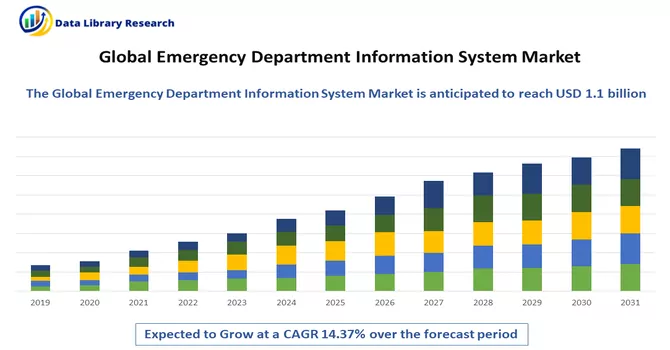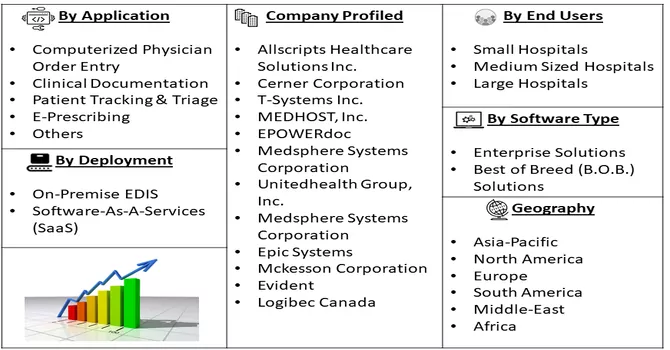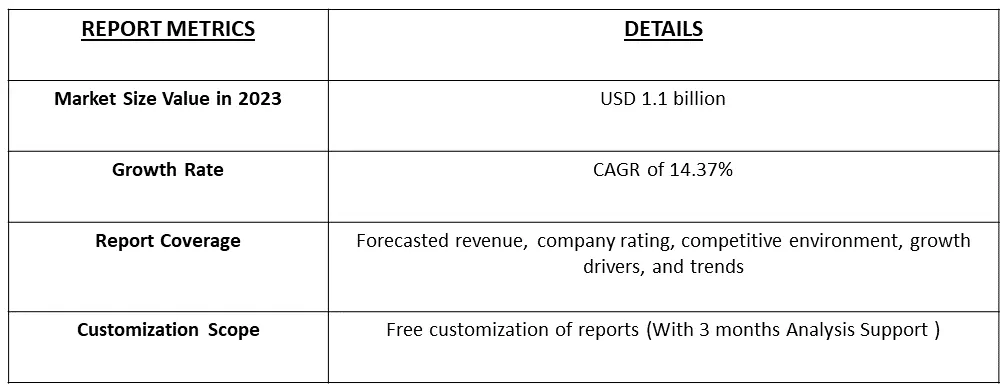The market size of the Emergency Department Information System is anticipated to expand from USD 1.1 billion in 2023, registering a Compound Annual Growth Rate (CAGR) of 14.37% over the forecast period spanning from 2023 to 2030.

Get Complete Analysis Of The Report - Download Free Sample PDF
An Emergency Department Information System (EDIS) is a specialized software solution designed to support and streamline the management and workflow of emergency departments in healthcare facilities. It serves as a comprehensive electronic tool to assist healthcare professionals in efficiently handling various aspects of patient care within the emergency department setting. Key functionalities of an Emergency Department Information System typically include patient registration, triage, electronic charting and documentation, order entry, tracking of patient progress, communication among healthcare providers, and reporting.
EDIS helps in streamlining and optimizing the workflow within emergency departments, leading to improved efficiency. This is crucial in emergency settings where timely and accurate information can significantly impact patient outcomes. Moreover, EDIS facilitates better coordination and communication among healthcare professionals, ensuring that patient information is readily available to the right individuals. This contributes to more informed decision-making and, consequently, enhanced patient care. Thus, these factors are expected to witness significant growth over the forecast period.
The integration of EDIS with telehealth solutions and remote patient monitoring is becoming more prevalent. This trend allows for better management of patients, especially in situations where in-person visits may be challenging. The development of mobile applications linked to EDIS allows patients to engage with the system, providing real-time updates, appointment scheduling, and access to their health records. This trend enhances patient engagement and satisfaction. These trends reflect the ongoing evolution of Emergency Department Information Systems to meet the changing needs of healthcare providers, improve patient outcomes, and enhance the overall efficiency of emergency care delivery.
Market Segmentation: The Emergency Department Information System Market is Segmented by Application (Computerized Physician Order Entry, Clinical Documentation, Patient Tracking & Triage, E-Prescribing, and Others), Deployment (On-Premise EDIS and Software-As-A-Services (SaaS)), Software Type (Enterprise Solutions and Best of Breed (B.O.B.) Solutions), End-User (Small Hospitals, Medium, Sized Hospitals, and Large Hospitals), and Geography (North America, Europe, Asia-Pacific, Middle East and Africa, and South America). The report offers the value (in USD million) for the above segments.

For Detailed Market Segmentation - Download Free Sample PDF
Market Drivers. :
The Rise in the Geriatric Population and Increasing Use of Data-Driven Technologies
The global population continues to age, with a significant increase in the number of elderly individuals, the healthcare landscape is undergoing profound changes. The geriatric population, typically aged 65 and above, is more susceptible to chronic illnesses and age-related conditions, leading to a surge in hospital admissions, including emergency department visits. This demographic shift has substantial implications for the Emergency Department Information System (EDIS) market. The aging population is associated with a higher prevalence of chronic diseases and complex health conditions. Consequently, emergency departments experience a rise in admissions, necessitating advanced EDIS solutions to manage and prioritize cases efficiently. Thus, owing to above-mentioned reasons the market is expected to witness significant growth over the studied period.
Emergency Department Information System Market Increase in the Number of Insured Population
The expansion of health insurance coverage has significant implications for the healthcare industry, including emergency care. The increase in the number of insured individuals has led to changes in healthcare utilization patterns and has prompted the adoption of advanced technologies, such as Emergency Department Information Systems (EDIS), to meet the evolving needs of a larger and more diverse patient population. With more individuals gaining access to health insurance, there is a corresponding increase in the utilization of healthcare services, including emergency department visits. This surge necessitates efficient and streamlined processes, which EDIS is designed to facilitate. Thus, owing to above-mentioned reasons the market is expected to witness significant growth over the studied period.
Market Restraints. :
Adverse Quality and Safety Implications Of EDIS
The Emergency Department Information Systems (EDIS) are designed to enhance efficiency and improve patient outcomes, challenges related to adverse quality and safety implications can hinder their growth in the market. It's crucial to address these issues to ensure that EDIS solutions effectively contribute to the overall improvement of emergency care. The inaccurate or incomplete data within the EDIS can lead to errors in patient identification, diagnosis, and treatment. Moreover, poorly designed user interfaces or complex workflows within EDIS may contribute to user errors and delays in critical decision-making. Thus, these factors are expected to slow down the growth of the studied market over the studied period.
The COVID-19 pandemic has had a profound impact on the Emergency Department Information Systems (EDIS) market, influencing trends, adoption rates, and priorities within the healthcare sector. The pandemic has accelerated the adoption of telehealth, and EDIS has adapted to support remote consultations and triage. This shift has allowed healthcare providers to manage patient inflow, reduce the risk of infection transmission, and prioritize cases more efficiently. EDIS has increasingly integrated with public health systems to facilitate real-time reporting of COVID-19 cases. This integration supports better coordination between emergency departments and public health agencies in responding to the pandemic. Thus, the COVID-19 pandemic has accelerated certain trends within the EDIS market, emphasizing the need for flexibility, remote capabilities, data-driven decision-making, and efficient resource management to ensure effective emergency care during public health crises.
Segmental Analysis :
Computerized Physician Order Entry (CPOE) Segment is Expected to Witness Significant Growth Over the Forecast Period
Computerized Physician Order Entry (CPOE) is a digital system that enables healthcare providers to directly enter medical orders and instructions into a computer system. It has been a transformative technology in healthcare, particularly in improving the accuracy, efficiency, and safety of the order-entry process. CPOE is often integrated with Electronic Health Records (EHR) and other clinical information systems, creating a seamless flow of information. This integration supports comprehensive patient care by providing a unified platform for healthcare professionals to access and update patient records. Thus, these factors are expected to witness significant growth over the forecast period.
Software-As-A-Services (SaaS) Segment is Expected to Witness Significant Growth Over the Forecast Period
Software-as-a-Service (SaaS) is a cloud computing model that delivers software applications over the internet on a subscription basis. Instead of purchasing and installing software on individual computers or servers, users can access the software and its features through a web browser. SaaS has become a popular deployment model across various industries due to its flexibility, scalability, and cost-effectiveness. The SaaS model eliminates the need for significant upfront investments in hardware and infrastructure. Emergency departments, including those in smaller healthcare facilities, can benefit from cost-effective deployment, making advanced EDIS technology more accessible. Thus, owing to such advantages, the segment is expected to witness significant growth over the forecast period.
Best of Breed (B.O.B.) Solutions Segment is Expected to Witness Significant Growth Over the Forecast Period
Best of Breed (B.O.B.) Solutions refers to the approach of selecting and implementing the best-performing, specialized software or systems for specific functions within an organization. In the context of healthcare, this approach involves choosing the most effective and specialized solutions for different departments or functions rather than opting for a one-size-fits-all integrated system. The B.O.B. approach allows healthcare organizations to customize their EDIS by choosing the solutions that best fit their specific requirements. This flexibility is crucial in adapting to the unique needs of different emergency departments within various healthcare settings. Thus, owing to such advantages, the segment is expected to witness significant growth over the forecast period.
Large Hospitals Segment is Expected to Witness Significant Growth Over the Forecast Period
Large hospitals play a critical role in healthcare, often serving as major medical hubs that cater to a wide range of medical needs, including emergency care. The implementation of Emergency Department Information Systems (EDIS) in large hospitals has become increasingly essential for optimizing operations, improving patient care, and ensuring efficient responses to emergencies. Large hospitals typically experience high patient volumes, especially in their emergency departments. EDIS helps manage and streamline patient flow, facilitating the efficient triage of individuals based on the severity of their conditions. The system assists in prioritizing cases, ensuring that critical patients receive prompt attention and resources, thus contributing to better outcomes. EDIS generates a wealth of data related to patient demographics, clinical history, and operational metrics. Large hospitals leverage this data for analytics, enabling data-driven decision-making to enhance overall emergency department performance. Thus, owing to such advantages, the segment is expected to witness significant growth over the forecast period.
North America Region is Expected to Witness Significant Growth Over the Forecast Period
North America stands out as a major market for emergency department information systems, particularly in countries like the United States and Canada. The prevalence of these systems has been widespread, with the COVID-19 pandemic acting as a catalyst for increased adoption of healthcare IT services in emergency departments throughout the region. The pandemic underscored the imperative for mobile health (mHealth) technologies and electronic medical records, emphasizing factors such as linked patient records, accurate patient data, cybersecurity, and interoperability. The surge in the aging population, more susceptible to chronic diseases, is expected to drive higher hospital admissions. Consequently, there is an increased demand for emergency department information systems to efficiently manage healthcare services. According to the Administration for Community Living's 2020 Profile of Older Americans, the number of individuals aged 65 and above in the United States is projected to reach 80.58 million by 2040 and 94.7 million by 2060.
The growth of the market in North America is further propelled by favorable government support. Notably, in June 2021, the United States Office of Information and Technology revised the Emergency Department Integration Software (EDIS) program services installation in hospitals. This initiative aims to enhance the tracking and management of patient care delivery in emergency departments. Such regulatory measures, facilitating streamlined access to emergency department information systems in hospitals and healthcare settings, are poised to drive market growth in the foreseeable future. In summary, the increasing adoption of healthcare IT solutions in North America positions the market for emergency department information systems for substantial growth in the coming years.

Get Complete Analysis Of The Report - Download Free Sample PDF
The market for Emergency Department Information Systems is characterized by competition and is dominated by a select group of key players. These major players offer their products on a global scale, contributing to the competitiveness of the Emergency Department Information System market. Leading participants in this market include:
Recent Development:
1) In March of 2022, HeartBeam, Inc. formalized agreements with Phoebe Putney Health System, including a Business Associate Agreement (BAA) and a Clinical Trial Agreement (CTA), to initiate a pilot study aimed at assessing the efficacy of HeartBeam’s Emergency Department (ED) Myocardial Infarction (MI) software product.
2) In a separate development in January 2022, Aidoc forged a partnership with Novant Health. Through the integration of Aidoc's AI platform, featuring seven FDA-cleared solutions designed for triage and timely notification of patients with acute medical conditions, Novant Health is proactively addressing the challenges posed by the Omicron variant. The collaborative effort is geared towards enhancing patient outcomes and mitigating emergency department (ED) length of stay amid the ongoing resource constraints.
Q1. What was the Emergency Department Information System Market size in 2023?
The market size of the Emergency Department Information System is anticipated to expand from USD 1.1 billion in 2023.
Q2. At what CAGR is the market projected to grow within the forecast period?
Emergency Department Information System Market is registering a Compound Annual Growth Rate (CAGR) of 14.37% over the forecast period.
Q3. Who are the key players in Emergency Department Information System Market?
Some key players operating in the market include
Q4. Which Region is expected to hold the highest Market share?
North America region is expected to hold the highest Market share.
Data Library Research are conducted by industry experts who offer insight on industry structure, market segmentations technology assessment and competitive landscape (CL), and penetration, as well as on emerging trends. Their analysis is based on primary interviews (~ 80%) and secondary research (~ 20%) as well as years of professional expertise in their respective industries. Adding to this, by analysing historical trends and current market positions, our analysts predict where the market will be headed for the next five years. Furthermore, the varying trends of segment & categories geographically presented are also studied and the estimated based on the primary & secondary research.
In this particular report from the supply side Data Library Research has conducted primary surveys (interviews) with the key level executives (VP, CEO’s, Marketing Director, Business Development Manager and SOFT) of the companies that active & prominent as well as the midsized organization
FIGURE 1: DLR RESEARH PROCESS

Extensive primary research was conducted to gain a deeper insight of the market and industry performance. The analysis is based on both primary and secondary research as well as years of professional expertise in the respective industries.
In addition to analysing current and historical trends, our analysts predict where the market is headed over the next five years.
It varies by segment for these categories geographically presented in the list of market tables. Speaking about this particular report we have conducted primary surveys (interviews) with the key level executives (VP, CEO’s, Marketing Director, Business Development Manager and many more) of the major players active in the market.
Secondary ResearchSecondary research was mainly used to collect and identify information useful for the extensive, technical, market-oriented, and Friend’s study of the Global Extra Neutral Alcohol. It was also used to obtain key information about major players, market classification and segmentation according to the industry trends, geographical markets, and developments related to the market and technology perspectives. For this study, analysts have gathered information from various credible sources, such as annual reports, sec filings, journals, white papers, SOFT presentations, and company web sites.
Market Size EstimationBoth, top-down and bottom-up approaches were used to estimate and validate the size of the Global market and to estimate the size of various other dependent submarkets in the overall Extra Neutral Alcohol. The key players in the market were identified through secondary research and their market contributions in the respective geographies were determined through primary and secondary research.
Forecast Model
